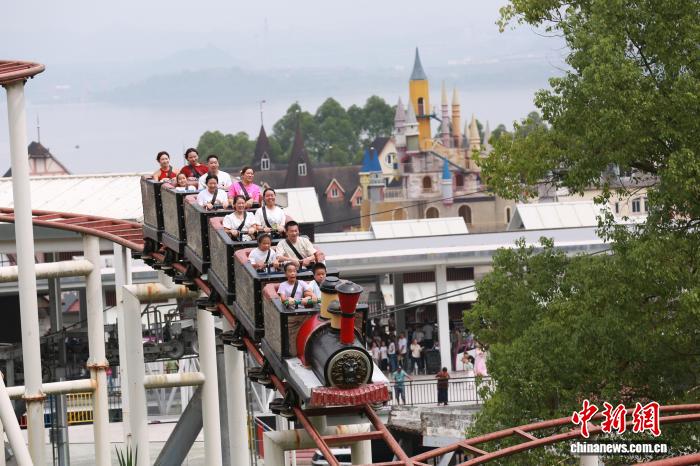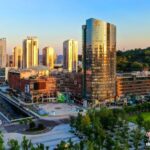Chongqing’s cultural tourism market demonstrated strong performance during the 2025 National Day and Mid-Autumn Festival holidays, ranking among the top ten most popular tourist cities nationwide, with the “holiday economy” vitality fully unleashed.
Data shows that the city’s tourist reception continued to rise. From October 1 to 8, Chongqing received 27.0159 million domestic tourists, representing a 4.2% year-on-year increase on a comparable basis. Domestic tourist spending reached 19.614 billion yuan, an 11.4% year-on-year increase on a comparable basis. The 130 key monitored attractions in the city cumulatively received 10.79 million visitors, an 11.2% year-on-year increase on a comparable basis.
The top five attractions were: Hongyadong Folk Custom Area (1.059 million visitors), Ciqikou Ancient Town (1.023 million visitors), Meixin Red Wine Town (1.012 million visitors), Wulong Karst Tourism Area (785,000 visitors), and Chongqing Zoo (530,000 visitors).
The 10 key monitored tourism and leisure streets in the city saw a 9.6% year-on-year increase in tourist visits. The top three in terms of visitor numbers were: Shibati Traditional Style Area in Yuzhong District (1.061 million visitors), Danzishi Old Street in Nan’an District (800,000 visitors), and Longmenhao Old Street in Nan’an District (551,000 visitors).
In the performing arts market, 29 major theaters and key performance spaces in Chongqing staged 567 performances cumulatively, a 15.4% year-on-year increase on a comparable basis. These performances attracted approximately 165,700 audience members, a 17.6% year-on-year increase on a comparable basis.
Regarding public cultural activities, Chongqing comprehensively increased performance supply and organized 793 various public cultural activities, with 848,000 cumulative participants. All 42 public libraries and 41 cultural centers in the city were open to the public free of charge and provided rich online services, receiving 940,700 in-person visitors and 1.0368 million online service users.
Notably, during the holiday period, museums and memorial halls in Chongqing completely eliminated the reservation system for visits and organized 72 exhibitions and 152 social education activities. Among these, 16 museums including the China Three Gorges Museum and Chongqing Sports Museum extended their opening hours. City museums cumulatively received 2.2068 million visitors, a 25.8% year-on-year increase.
Additionally, various districts and counties organized intangible cultural heritage inheritance activities including intangible cultural heritage experiences in scenic areas, intangible cultural heritage food consumption seasons, intangible cultural heritage study tours, and lantern festivals. During the holiday period, more than 230 intangible cultural heritage exhibition and performance activities were held, representing a 12% year-on-year increase, with over 1 million participants, a 15% year-on-year increase.
Hongyadong Folk Custom Area
Hongyadong is a popular tourist attraction in Chongqing, China, built on the steep cliffs along the Jialing River. It is a modern recreation of the traditional stilted houses (Diaojiaolou) that characterized old Chongqing, designed to resemble the ancient city’s bustling commercial docks. The area now features a multi-level complex of shops, restaurants, and teahouses, offering visitors a glimpse into the city’s historical architectural style and folk culture.
Ciqikou Ancient Town
Ciqikou Ancient Town is a historic riverside settlement located in Chongqing, China, dating back over 1,000 years to the Song Dynasty. It flourished as a busy commercial port during the Ming and Qing Dynasties due to its strategic location along the Jialing River. Today, it is a popular tourist attraction known for its well-preserved traditional architecture, ancient tea houses, and local crafts.
Meixin Red Wine Town
Meixin Red Wine Town is a modern cultural and tourism development in China that celebrates the country’s growing wine industry. While it does not have a long historical legacy, it was established to promote Chinese winemaking and oenotourism through immersive experiences. The town features European-inspired architecture, vineyards, and facilities dedicated to wine production, tastings, and cultural events.
Wulong Karst Tourism Area
The Wulong Karst Tourism Area in China is a UNESCO World Heritage site renowned for its spectacular karst landscapes, including natural bridges, gorges, and massive sinkholes. Its geological formations were shaped over millions of years by water erosion on the limestone bedrock. The area gained international fame as a filming location for the movie “Transformers: Age of Extinction.”
Chongqing Zoo
Chongqing Zoo, opened in 1955, is one of the largest urban zoos in China. It is most famous for its successful panda breeding program and is home to a diverse collection of animals, including rare species native to the region. The zoo serves as a key center for wildlife conservation, research, and public education in southwestern China.
Shibati Traditional Style Area
The Shibati Traditional Style Area is a historic neighborhood in Chongqing, China, known for its traditional stilted houses (diaojiaolou) built along the steep hillsides. It represents one of the last remaining examples of old Chongqing’s architectural style, dating back over a century, and was historically a bustling residential and commercial hub. Today, it stands as a cultural relic, offering a glimpse into the city’s past amid rapid modernization.
Danzishi Old Street
Danzishi Old Street is a historic commercial street located in Chongqing, China, dating back over 600 years to the Ming Dynasty. It was originally a bustling wharf area and trading hub along the Yangtze River. Today, it has been restored as a popular tourist destination featuring traditional architecture, local snacks, and cultural shops while preserving its ancient charm.
Longmenhao Old Street
Longmenhao Old Street is a historic commercial district located along the banks of the Huangpu River in Shanghai. It dates back to the Qing Dynasty when it served as a bustling port and trading hub for grain and other goods. Today, it has been revitalized with restored traditional architecture, shops, and dining options that blend its rich heritage with modern urban life.




